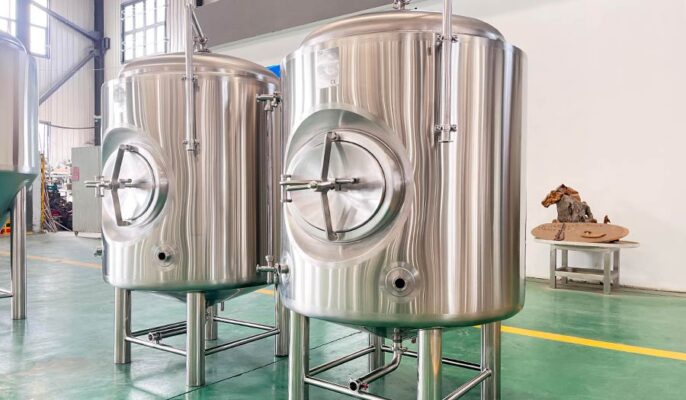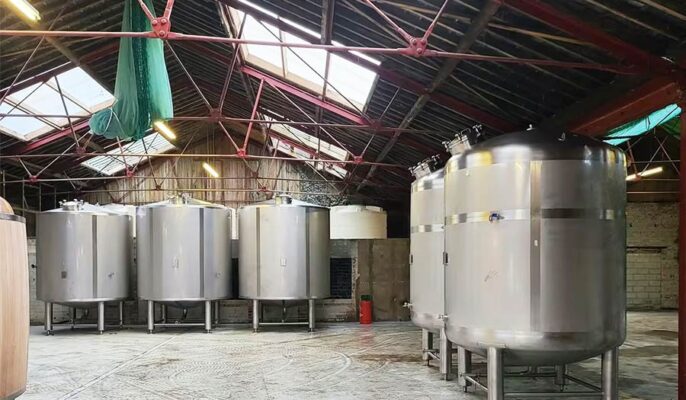Резервуары из нержавеющей стали play a vital role in beer brewing and other industrial applications. Their corrosion resistance and durability make them ideal for storing and handling a variety of liquids. However, even the highest quality stainless steel requires regular cleaning and maintenance to ensure its performance and sanitation standards. Cleaning stainless steel tanks not only prevents the accumulation of contamination and residue but also extends the life of the tank and ensures the quality of the end product. In this article, we will show you how to clean stainless steel tanks safely and effectively.
Что такое stainless steel water tank and what is its role?
A stainless steel water tank is a container made of stainless steel used to store and process water, beverages, chemicals, and industrial liquids. Stainless steel is widely used in various fields due to its excellent corrosion resistance, wear resistance, and high-temperature resistance.
Features of stainless steel water tanks:
- Corrosion resistance: The main advantage of stainless steel is its excellent corrosion resistance, which can resist the erosion of moisture, in acidic and alkaline environments.
- Strength and durability: Stainless steel has good mechanical strength and can withstand high pressure and mechanical shock, extending its service life.
- Hygiene: The surface of stainless steel is smooth and easy to clean, which can effectively avoid bacterial growth and contamination, and is very suitable for the food and beverage industry.
- Beauty: The surface of stainless steel is modern and beautiful, often used in places that require a neat appearance.
The role of stainless steel water tanks
Stainless steel water tanks have become an ideal choice for liquid storage and processing in many industries due to their superior durability, hygiene, and corrosion resistance. Through proper maintenance and cleaning, its performance can be ensured to be stable for a long time to meet various application requirements.
- Beer Brewing and Beverage Production: In breweries and beverage production, stainless steel tanks are used to store raw materials (such as water and malt), liquids during the fermentation process, and the final product. These tanks can maintain the freshness of liquids and prevent external contamination.
- Industrial Applications: In industrial production, stainless steel tanks are used to store chemicals, pharmaceuticals, and other liquid raw materials. Their corrosion resistance ensures that chemicals will not react to the container or cause leakage.
- Construction and Water Treatment: In construction sites and water treatment facilities, stainless steel tanks are used to store and distribute clean or treated water. Their sturdy structure can withstand large-capacity liquid storage needs.
- Agriculture and Breeding: In agriculture and breeding, stainless steel tanks are used to store drinking water and other liquid supplies to ensure the health of animals and the smooth progress of the production process.

Why should stainless steel water tanks be cleaned?
To maintain the hygiene of water, water tanks must be cleaned. The following substances may accumulate in the water tank over time:
- Dirt
- Dust
- Debris
- Плесень
- Dangerous bacteria
Предотвращение загрязнения
Stainless steel water tanks are used to store and process various liquids, such as water, beverages, chemicals, or industrial raw materials. If they are not cleaned for a long time, bacteria, mold, algae, and other microorganisms may accumulate in the water tank. These contaminants not only affect the quality of the stored liquid but may also cause health risks or production problems.
Maintain liquid quality
During beer brewing, beverage production, or other food processing, the sanitation of stainless steel water tanks directly affects the quality of the final product. Residues, sediments, or microbial contamination may change the taste, smell, or appearance of the liquid and reduce product quality. Regular cleaning ensures that the liquid remains fresh and meets quality standards.
Prevent sediment accumulation
Stainless steel water tanks may accumulate minerals, sediments, and other residues during use. If not removed in time, these sediments may cause the water tank to clog, reduce flow, and even affect the normal operation of the equipment.
Improve equipment life
Regular cleaning not only prevents contamination and sediment but also maintains the structure and function of stainless steel water tanks. Long-term accumulation of dirt and corrosion may cause damage to the water tank material, thus shortening its service life. Proper cleaning and maintenance can extend the service life of the water tank and reduce the frequency of repair and replacement.
Ensure compliance
In many industries, especially in the food and beverage production industry, there are strict regulations and standards for the hygiene and cleanliness of equipment. Regular cleaning of stainless steel water tanks can ensure compliance with relevant regulations and industry standards, and avoid legal and safety issues caused by hygiene issues.
Optimize performance
A clean water tank can maintain optimal performance. Sediment and dirt can affect the heat exchange efficiency, liquid storage capacity, and overall operating efficiency of the water tank. By keeping the water tank clean, it can ensure that it can operate normally under various working conditions and achieve the best results.
Improve operational safety
The accumulation of dirt and sediment may not only cause equipment failure but also cause safety hazards during operation. For example, a corroded or damaged water tank may leak, causing danger or environmental pollution. Regular cleaning can reduce these risks and ensure the safety of the operation process.

Advantages of Stainless Steel Tanks
Долговечность
Stainless steels are more corrosion-resistant than regular carbon steels in a variety of applications. They last longer due to their high durability and corrosion resistance. Stainless steel is essential to ensure that the quality of the items you keep is not affected. If you place the tank outdoors, stainless steel can also help you eliminate weathering issues that may occur when using steel or plastic.
Environmental
The impact of mining and the materials used in production on the environment is a key consideration when deciding which storage tank to buy. Steel is the most recyclable material in the world. New stainless steel can be recycled 60% to 70% without any loss of quality, and its carbon impact is minimized because little energy is required to produce it. In addition to being a safe metal alloy, stainless steel will not deteriorate or release pollutants into the environment.
Легко чистить
Stainless steel has a smooth surface, is not easy to adhere to dirt, and is easy to clean and disinfect. This makes stainless steel tanks particularly suitable for the food and beverage industry, which can effectively avoid bacterial growth and cross-contamination, ensuring the hygienic safety of products.
High-temperature resistance
Нержавеющая сталь способна выдерживать высокотемпературные среды, ее нелегко деформировать или повредить при перепадах температуры. Это делает резервуары из нержавеющей стали пригодными для применения в областях, требующих работы при высоких температурах, таких как хранение горячей воды, пищевая промышленность и химические реакции.
How to clean a stainless steel water tank?
Pretreatment and preparation
Прежде чем приступить к очистке, убедитесь, что бак для воды пуст, и выполните предварительную промывку с помощью водяного пистолета высокого давления. Этот шаг удаляет видимую грязь и остатки жидкости в резервуаре для воды и подготавливает его к последующей очистке. Подготовьте необходимые инструменты и чистящие средства, включая щетки, губки, мягкие салфетки и водяные пистолеты высокого давления, а также подходящие чистящие средства, например щелочные или кислотные.
Selecting cleaning agents
Выберите подходящее чистящее средство в зависимости от типа остатков в резервуаре для воды. Щелочные чистящие средства подходят для удаления жира и органических веществ, а кислотные эффективны для удаления минеральных отложений и накипи. Для пивоваренных заводов можно использовать специальные чистящие средства для пивоваренных заводов, которые более эффективно справляются с остатками хмеля и дрожжей.
Этапы очистки
- Предварительное ополаскивание: с помощью водяного пистолета высокого давления тщательно промойте внутреннюю поверхность бака для воды, чтобы удалить большую часть видимой грязи. Это поможет чистящему средству работать лучше.
- Нанесите чистящее средство: Добавьте соответствующее количество чистящего средства в резервуар для воды и равномерно нанесите его с помощью щетки или губки. Убедитесь, что чистящее средство покрывает внутренние стенки и дно резервуара для воды, а также обрабатывает труднодоступные места.
- Замочите и почистите: Оставьте моющее средство на некоторое время (обычно от 30 минут до 1 часа), чтобы оно разложило грязь. Затем с помощью щетки или губки протрите внутренние стенки, особенно в местах скопления грязи.
- Тщательно промойте: тщательно промойте внутреннюю часть резервуара для воды большим количеством чистой воды, чтобы убедиться, что моющее средство полностью удалено. Этот шаг можно повторить несколько раз, пока вода не станет прозрачной и не появится пена.
- Проверьте и высушите: Проверьте, чистая ли внутренняя поверхность резервуара для воды. При необходимости промойте еще раз. После очистки протрите внутреннюю поверхность резервуара для воды чистой тканью и убедитесь, что резервуар для воды полностью высох, прежде чем использовать его.
Maintenance and inspection
Регулярная очистка резервуара для воды - залог поддержания его хорошего состояния. Составьте план регулярной очистки и записывайте дату, чистящее средство и метод каждой очистки. Кроме того, регулярно проверяйте состояние бака для воды, особенно сварных швов и соединений, чтобы убедиться в отсутствии коррозии или повреждений. При обнаружении каких-либо проблем своевременно устраняйте их.
ЧАСТО ЗАДАВАЕМЫЕ ВОПРОСЫ
Why do stainless steel tanks have dirt and deposits?
В резервуарах из нержавеющей стали в процессе эксплуатации могут образовываться загрязнения и отложения из-за минералов, жира, химикатов или остатков микроорганизмов в жидкости. Особенно часто отложения и грязь накапливаются при длительном хранении жидкостей или в условиях высокой температуры. Поэтому регулярная очистка необходима для предотвращения влияния этих проблем на использование резервуара и качество жидкости.
How to clean the outside of a stainless steel tank?
Простое мыло, мягкое моющее средство или нашатырный спирт в теплой воде, нанесенные мягкой тканью или нейлоновой губкой, - лучший выбор для чистки нержавеющей стали. В редких случаях может потребоваться самая мягкая нейлоновая губка. После ополаскивания вытрите насухо мягкой тканью.
How to choose a suitable detergent?
Выбор моющего средства должен основываться на характере остатков жидкости. Щелочные моющие средства подходят для удаления жира и органических веществ, а кислотные - для удаления минеральных отложений и накипи. Для таких специфических производств, как пивоварение, эффективнее использовать специализированные моющие средства. Обязательно следуйте инструкциям по применению и выбирайте моющее средство, совместимое с нержавеющей сталью.
Is it necessary to disinfect after cleaning the stainless steel tank?
В некоторых отраслях, особенно в пищевой промышленности и производстве напитков, после очистки необходимо провести дезинфекцию. Дезинфекция позволяет дополнительно удалить возможные остатки микроорганизмов и обеспечить гигиену резервуара. Используйте подходящее дезинфицирующее средство и следуйте инструкциям по применению, чтобы обеспечить тщательную дезинфекцию.




